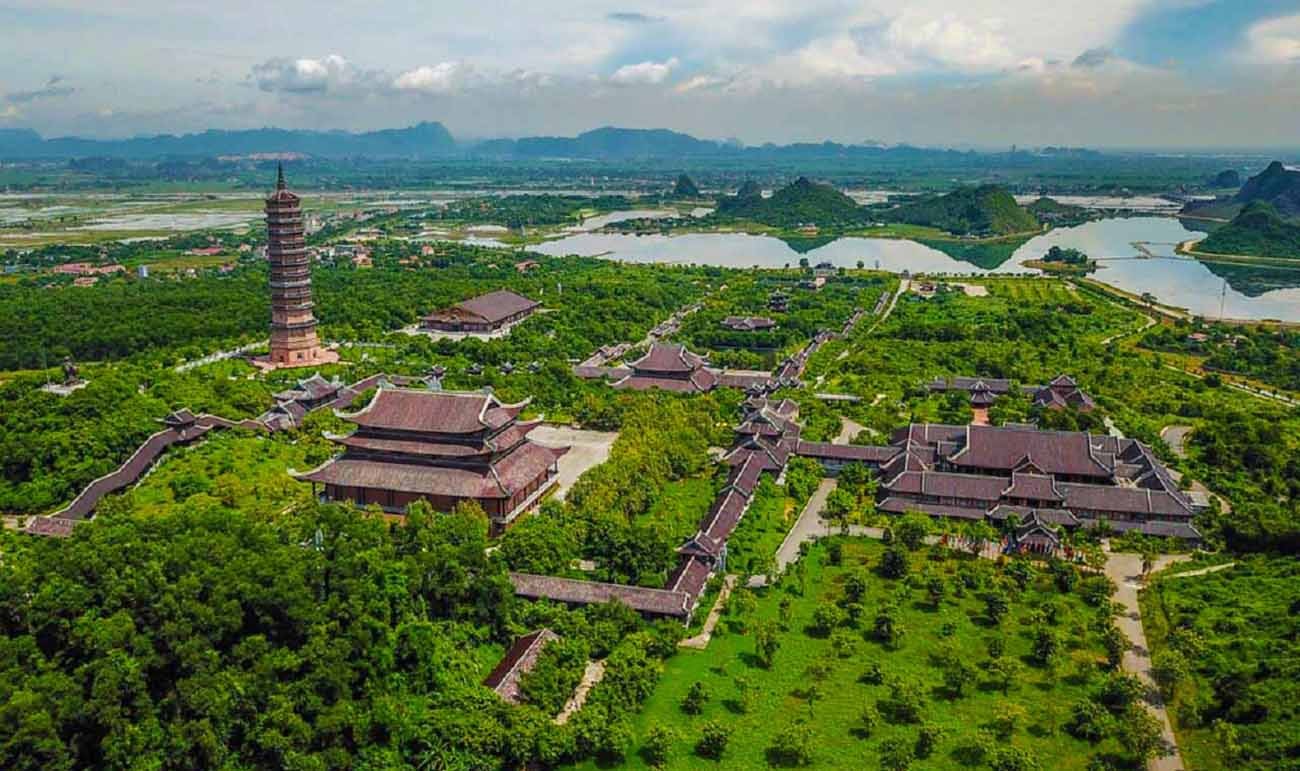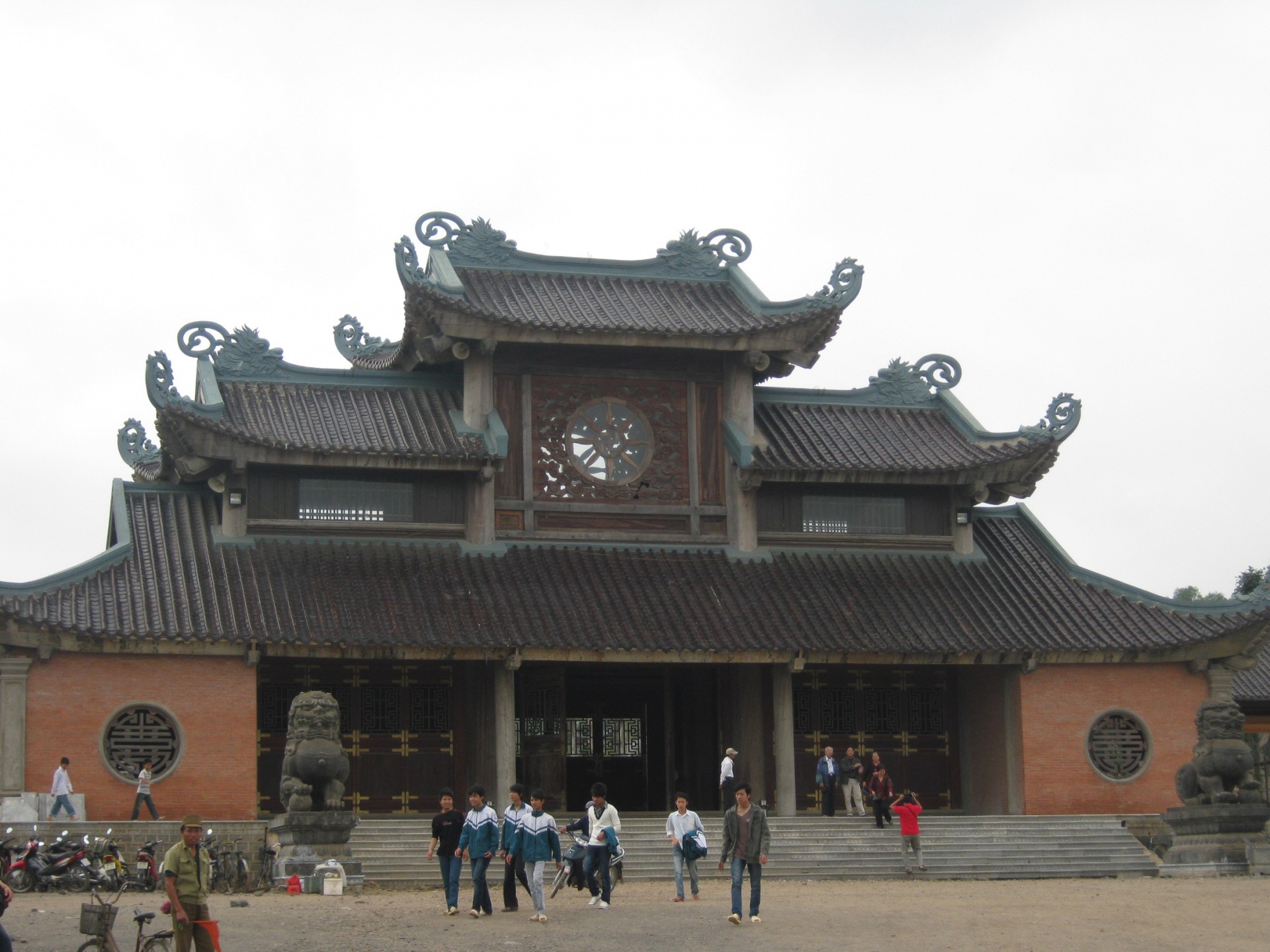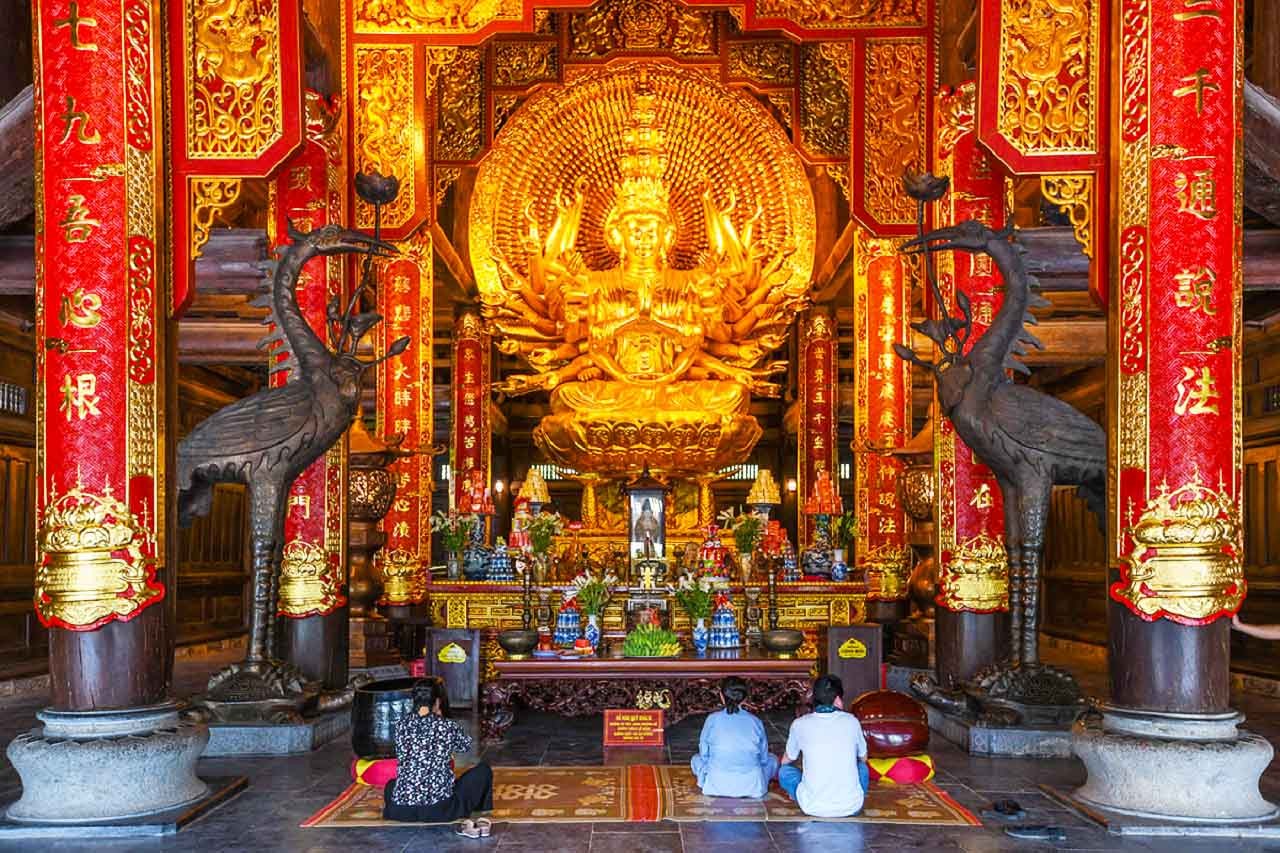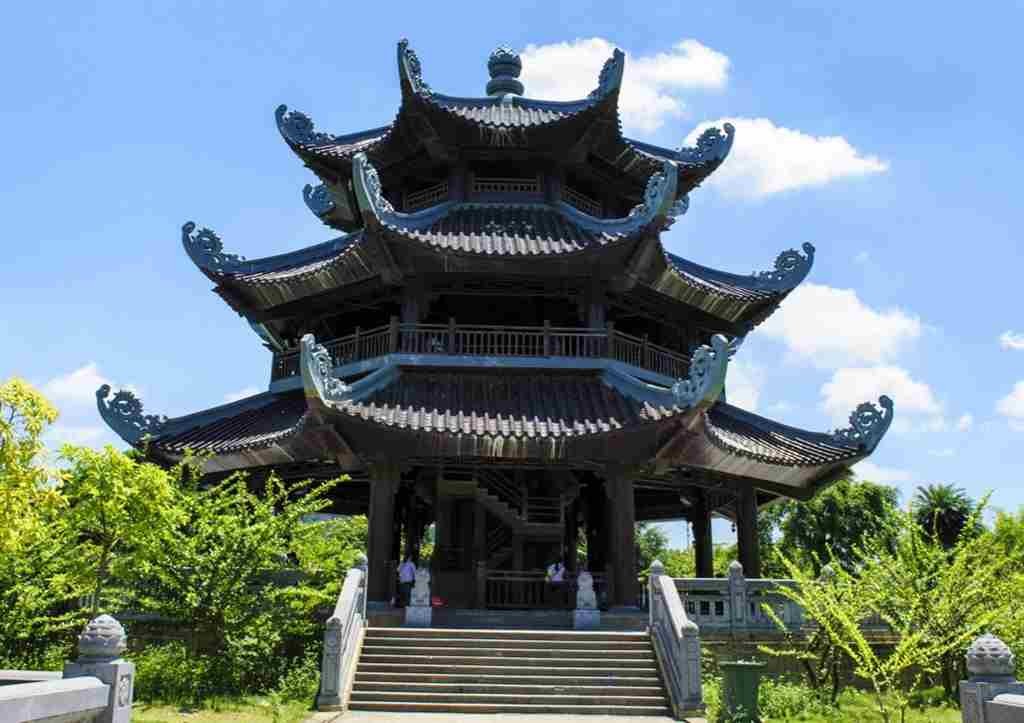Exploring Bai Dinh Pagoda offers a captivating glimpse into Vietnam’s rich spiritual heritage, but how much time is needed to visit Bai Dinh Pagoda? Allow SIXT.VN to guide you through planning your visit, ensuring you experience the best of this magnificent complex in Ninh Binh. With our expertise, you can seamlessly navigate the sprawling grounds, discover hidden gems, and tailor your visit to your interests. From transportation to accommodations, SIXT.VN provides all-encompassing services that let you experience Vietnamese culture without any trouble. Key services include airport pick-up/drop-off, hotel room arrangement, and travel itinerary consultation.
1. Understanding the Scale of Bai Dinh Pagoda
Bai Dinh Pagoda is not just one temple; it’s a sprawling complex of both ancient and newly constructed temples, halls, and structures. According to research from the Vietnam National Administration of Tourism, in 2023, Ninh Binh Province welcomed over 4.5 million visitors, with Bai Dinh Pagoda being a primary attraction, highlighting its significance in Vietnam’s tourism landscape.
To fully appreciate its grandeur and spiritual significance, understanding its scale is crucial for planning your visit.
1.1. How large is the area?
Bai Dinh Pagoda is massive. The new complex alone covers 80 hectares (almost 200 acres). This expansive area houses multiple structures, including:
- Tam The Hall: A grand hall dedicated to the past, present, and future Buddhas.
- Bao Thap Tower (Stupa): A towering structure that houses sacred relics.
- Bell Tower: Featuring a massive bronze bell.
- Arhat Corridor: A long corridor lined with 500 Arhat statues.
 Overview of Bai Dinh Pagoda complex
Overview of Bai Dinh Pagoda complex
1.2. How long does it take to walk around Bai Dinh Pagoda?
Walking around the entire Bai Dinh Pagoda complex can take a significant amount of time. According to a survey conducted by TripAdvisor in 2024, visitors spend an average of 3 to 5 hours exploring the entire complex.
- Basic Exploration: A quick tour covering the main halls and the Arhat corridor might take around 2-3 hours.
- Complete Exploration: To see everything, including the Bao Thap Tower, the ancient pagoda, and taking your time to appreciate the details, plan for at least 4-6 hours.
1.3. What is the location and tourist map?
Bai Dinh Pagoda is located in Gia Sinh commune, Gia Vien district, Ninh Binh province. It’s approximately 95 km (60 miles) south of Hanoi.
- Proximity to other attractions: It’s close to other popular tourist spots like Trang An (12 km) and Mua Cave (16 km), making it easy to combine these into a single trip.
- Navigating the complex: The complex is divided into the ancient pagoda on the mountain and the new pagoda at the foot of the mountain. It’s helpful to have a Bai Dinh Pagoda map (available at the entrance) to navigate effectively.
2. Deciding How Much Time to Spend: Factors to Consider
How much time is needed to visit Bai Dinh Pagoda can depend on your personal preferences, interests, and physical condition.
2.1. How religious are you?
If you’re deeply interested in Buddhist practices, rituals, and the spiritual aspects of the pagoda, you’ll likely want to spend more time exploring the temples, meditating, and participating in ceremonies.
- Spiritual immersion: Allocate extra time to participate in prayers, observe monks, and soak in the serene atmosphere.
- Devotional activities: Consider visiting during festivals to witness special religious events, which may require an entire day.
2.2. What is your level of interest in architecture and history?
Bai Dinh Pagoda is renowned for its unique architecture and historical significance. If you’re keen on learning about the intricate designs, historical relics, and cultural stories, you’ll want to dedicate more time to explore each structure.
- Architectural appreciation: Take time to examine the details of the halls, towers, and statues, paying attention to the traditional Vietnamese architectural styles.
- Historical context: Read the information plaques, hire a guide, or research beforehand to understand the historical context of each site.
2.3. How much walking are you comfortable with?
The Bai Dinh Pagoda complex is expansive, requiring a considerable amount of walking. Your physical condition and comfort level with walking will influence how much time you spend exploring the site.
- Accessibility: Consider renting an electric car to minimize walking distances, especially if you have mobility issues or are traveling with elderly individuals.
- Breaks: Plan for frequent breaks to rest and hydrate, particularly during hot weather.
2.4. Are you combining Bai Dinh with other attractions?
Many visitors combine a trip to Bai Dinh Pagoda with other nearby attractions like Trang An, Tam Coc, or Hoa Lu. If you’re planning a combined tour, you’ll need to allocate your time accordingly.
- Full-day tour: A combined tour of Bai Dinh and Trang An can take an entire day (8-10 hours), including travel time between sites.
- Half-day tour: If you only have a half-day, focus on either Bai Dinh Pagoda or another attraction to avoid rushing.
3. A Suggested Itinerary Based on Time Availability
Here are some sample itineraries based on the amount of time you have available to visit Bai Dinh Pagoda.
3.1. Quick visit (2-3 hours):
This itinerary is suitable for those with limited time who want to see the highlights of Bai Dinh Pagoda.
- Arrival and Electric Car: Arrive at the parking lot and take an electric car to the main entrance. This saves time and energy.
- Tam Quan Gate: Pass through the impressive Three-Entrance Gate, taking a moment to appreciate its architecture.
- Arhat Corridor: Walk along a section of the Arhat Corridor, admiring the detailed statues. Focus on a smaller segment to conserve time.
- Tam The Hall: Visit the Tam The Hall to see the grand statues of the Buddhas. Spend a brief period here, focusing on the main features.
- Departure: Take an electric car back to the parking lot.
 Tam Quan Gate at Bai Dinh Pagoda
Tam Quan Gate at Bai Dinh Pagoda
3.2. Standard visit (4-5 hours):
This itinerary allows a more thorough exploration of the key sites within the Bai Dinh Pagoda complex.
- Arrival and Electric Car: Take an electric car from the parking lot to the main entrance.
- Tam Quan Gate: Enter through the Three-Entrance Gate, appreciating its impressive structure.
- Bell Tower: Visit the Bell Tower and see the massive bronze bell. Take some photos and learn about its significance.
- Arhat Corridor: Walk the entire Arhat Corridor, observing the 500 Arhat statues. Enjoy the peaceful atmosphere.
- Hall of Bodhisattva Avalokitesvara: Explore the Hall of Bodhisattva Avalokitesvara, admiring the bronze statue with many eyes and hands.
- Tam The Hall: Visit the Tam The Hall and spend some time admiring the statues of the Buddhas.
- Electric Car to Departure: Use the electric car service to return to the parking lot.
3.3. Extended visit (6+ hours):
This itinerary is for those who want to explore every corner of Bai Dinh Pagoda and its surroundings.
- Arrival and Electric Car: Take an electric car to the main entrance.
- Tam Quan Gate: Pass through the Three-Entrance Gate.
- Bell Tower: Explore the Bell Tower and its massive bronze bell.
- Arhat Corridor: Walk the entire Arhat Corridor, taking in the detail of each statue.
- Hall of Bodhisattva Avalokitesvara: Spend time in the Hall of Bodhisattva Avalokitesvara, observing the bronze statue.
- Tam The Hall: Visit the Tam The Hall and appreciate the Buddhas’ statues.
- Bao Thap Tower (Stupa): Climb the Bao Thap Tower for panoramic views of the area (allow extra time and energy for the climb).
- Gieng Ngoc (The Pearl Well): Visit the ancient well and learn about its history.
- Ancient Bai Dinh Pagoda: Walk to the ancient pagoda (requires a significant walk or electric car ride) and explore the caves and temples.
- Maitreya Statue: Visit the Maitreya Statue on the highest hill.
- Electric Car to Departure: Use the electric car service to return to the parking lot.
 The Hall of Bodhisattva Avalokitesvara
The Hall of Bodhisattva Avalokitesvara
4. Tips for Making the Most of Your Visit
To ensure a smooth and enjoyable visit to Bai Dinh Pagoda, consider these tips.
4.1. What is the best time to visit?
- Spring months: The ideal time to visit is during the spring months (January to March) when the weather is warm and dry.
- Bai Dinh Festival: If you’re interested in cultural events, visit during the Bai Dinh festival (starts on the 6th day of the Lunar New Year).
- Early morning: To avoid crowds, arrive early in the morning before tour groups arrive.
4.2. What to wear?
- Respectful clothing: Dress modestly with clothing that covers your shoulders and knees.
- Comfortable shoes: Wear comfortable walking shoes as you’ll be doing a lot of walking.
- Sun protection: Bring sunscreen, a hat, and sunglasses to protect yourself from the sun.
4.3. How to get around?
- Electric cars: Utilize the electric car service to minimize walking distances.
- Walking: Walking is a great way to explore individual sites within the complex.
- Maps: Grab a map at the entrance to help navigate the area.
4.4. Other essential tips:
- Stay hydrated: Bring water, especially during hot weather.
- Snacks: Pack some snacks to keep your energy levels up.
- Cash: Bring cash for entrance fees (if any), electric car tickets, and souvenirs.
- Guides: Consider hiring a local guide to learn more about the history and culture of Bai Dinh Pagoda.
5. Combining Bai Dinh Pagoda with Other Ninh Binh Attractions
Ninh Binh is home to several other attractions that can be easily combined with a visit to Bai Dinh Pagoda.
5.1. Trang An
Trang An is a UNESCO World Heritage site known for its stunning karst landscapes, caves, and boat tours. According to UNESCO, Trang An showcases exceptional geological and natural values, attracting researchers and tourists worldwide.
- Boat Tours: Take a scenic boat tour through the caves and waterways.
- Time Needed: Allocate 3-4 hours for a boat tour and exploring the area.
- Travel time from Bai Dinh: Approximately 15-20 minutes by car.
5.2. Tam Coc
Tam Coc, also known as “Halong Bay on Land,” features beautiful rice paddies, limestone karsts, and cave systems.
- Boat Rides: Enjoy a relaxing boat ride along the Ngo Dong River.
- Bich Dong Pagoda: Visit the nearby Bich Dong Pagoda, a series of temples built into the mountainside.
- Time Needed: Plan for 4-5 hours to explore Tam Coc and Bich Dong.
- Travel time from Bai Dinh: About 30 minutes by car.
5.3. Hoa Lu Ancient Capital
Hoa Lu was the ancient capital of Vietnam during the Dinh and Le dynasties.
- Historical Sites: Explore the Dinh and Le temples, learning about Vietnam’s early history.
- Time Needed: Allow 2-3 hours to visit the temples and surrounding area.
- Travel time from Bai Dinh: Approximately 25 minutes by car.
5.4. Mua Cave
Mua Cave offers panoramic views of the Ninh Binh countryside from the top of a limestone mountain.
- Climbing: Climb the steps to the top for breathtaking views.
- Time Needed: Plan for 2-3 hours, including the climb.
- Travel time from Bai Dinh: About 20 minutes by car.
 Bell Tower at Bai Dinh Pagoda
Bell Tower at Bai Dinh Pagoda
6. Booking Your Trip with SIXT.VN
Planning a trip to Bai Dinh Pagoda and other attractions in Ninh Binh can be overwhelming. SIXT.VN offers a range of services to make your journey seamless and enjoyable.
6.1. Tour Packages
SIXT.VN offers various tour packages that combine Bai Dinh Pagoda with other attractions, providing a comprehensive experience of Ninh Binh.
- Full-day Tours: Bai Dinh – Trang An Boat Trip
- Multi-day Tours: Hoa Lu – Am Tien Cave – Tam Coc – Bich Dong – Bai Dinh – Trang An
6.2. Transportation Services
SIXT.VN provides reliable and comfortable transportation services to and from Bai Dinh Pagoda.
- Private Car: Hire a private car for a hassle-free journey from Hanoi or other locations.
- Airport Transfer: Arrange airport transfers for a smooth arrival and departure experience.
6.3. Accommodation Options
SIXT.VN offers a range of accommodation options to suit your budget and preferences.
- Hotels: Choose from a variety of hotels in Ninh Binh, ranging from budget-friendly to luxury.
- Homestays: Experience local hospitality by staying in a traditional homestay.
6.4. Booking Process
Booking your trip with SIXT.VN is easy and convenient.
- Visit SIXT.VN Website: Browse the website to explore the available tour packages, transportation services, and accommodation options.
- Select Your Preferences: Choose your preferred services and customize your itinerary.
- Contact Us: Reach out to our customer support team via Hotline/WhatsApp: +84 986 244 358 for personalized assistance.
- Confirm Your Booking: Review your booking details and confirm your reservation.
- Enjoy Your Trip: Relax and enjoy your well-planned trip to Bai Dinh Pagoda and Ninh Binh.
7. Understanding Bai Dinh Pagoda’s Significance
Bai Dinh Pagoda is more than just a tourist attraction; it’s a site of immense cultural and spiritual significance in Vietnam.
7.1. What is the history of Bai Dinh Pagoda?
Bai Dinh Pagoda has a rich history that dates back over 1,000 years.
- Ancient Pagoda: The ancient pagoda is located in the mountains and was a place of worship for Buddhist deities and mountain spirits.
- New Pagoda: The new complex was built in the early 2000s to accommodate the increasing number of visitors and pilgrims.
7.2. How do the architectural highlights of the pagoda reflect Vietnamese culture?
The architecture of Bai Dinh Pagoda reflects traditional Vietnamese styles with influences from Buddhism and local beliefs.
- Intricate Designs: The intricate designs of the halls, towers, and statues showcase the skill and artistry of Vietnamese craftsmen.
- Symbolic Elements: Many elements of the architecture have symbolic meanings, such as the lotus flower representing purity and enlightenment.
7.3. What are some customs and etiquette to keep in mind while visiting?
When visiting Bai Dinh Pagoda, it’s important to respect local customs and etiquette.
- Dress Modestly: Wear clothing that covers your shoulders and knees.
- Remove Shoes: Remove your shoes before entering the halls and temples.
- Quiet: Maintain a quiet and respectful demeanor while inside the complex.
- Photography: Ask for permission before taking photos of monks or religious ceremonies.
- Offerings: If you wish to make an offering, follow the guidance of the monks or temple staff.
8. Essential Vietnamese Phrases for Your Visit
Knowing a few basic Vietnamese phrases can enhance your experience and show respect for the local culture.
8.1. Greetings
- Hello: Xin chào (Sin Chao)
- Good morning: Chào buổi sáng (Chao Buoi Sang)
- Good evening: Chào buổi tối (Chao Buoi Toi)
- Goodbye: Tạm biệt (Tam Biet)
8.2. Basic Phrases
- Thank you: Cảm ơn (Cam On)
- You’re welcome: Không có gì (Khong Co Gi)
- Please: Làm ơn (Lam On)
- Excuse me: Xin lỗi (Sin Loi)
- Yes: Vâng (Vang)
- No: Không (Khong)
8.3. Useful Questions
- How much does it cost?: Cái này bao nhiêu tiền? (Cai Nay Bao Nhieu Tien?)
- Where is the restroom?: Nhà vệ sinh ở đâu? (Nha Ve Sinh O Dau?)
- Can you help me?: Bạn có thể giúp tôi không? (Ban Co The Giup Toi Khong?)
- I don’t understand: Tôi không hiểu (Toi Khong Hieu)
8.4. Phrases for Transportation
- To Bai Dinh Pagoda, please: Đến chùa Bái Đính, làm ơn (Den Chua Bai Dinh, Lam On)
- How far is it to…?: Đến … bao xa? (Den … Bao Xa?)
- Stop here, please: Dừng ở đây, làm ơn (Dung O Day, Lam On)
9. Bai Dinh Pagoda at Night: A Unique Experience
Visiting Bai Dinh Pagoda at night offers a completely different perspective and atmosphere.
9.1. Is Bai Dinh Pagoda open at night?
Yes, Bai Dinh Pagoda is open until 10:00 PM daily, allowing visitors to experience its beauty under the stars.
9.2. What can you see and do at night?
- Illuminated Structures: The entire complex is illuminated with soft, glowing lights, highlighting the intricate details of the architecture and statues.
- Peaceful Atmosphere: The night brings a sense of tranquility and serenity, making it a perfect time for meditation and reflection.
- Photography: Capture stunning photos of the illuminated pagodas and halls against the night sky.
- Fewer Crowds: Enjoy the complex with fewer crowds, allowing for a more intimate experience.
9.3. Tips for visiting at night:
- Safety: Stick to well-lit areas and be aware of your surroundings.
- Transportation: Arrange transportation in advance, as public transportation may be limited at night.
- Weather: Check the weather forecast and dress accordingly.
- Respect: Maintain a quiet and respectful demeanor, especially during prayer times.
 Bai Dinh Pagoda at Night
Bai Dinh Pagoda at Night
10. Answering Your Frequently Asked Questions about Bai Dinh Pagoda
Here are some frequently asked questions to help you plan your visit to Bai Dinh Pagoda.
10.1. What is Bai Dinh Pagoda famous for?
Bai Dinh Pagoda is famous for being the largest Buddhist complex in Vietnam and for holding several records, including the largest bronze Buddha statue in Asia and the longest Arhat corridor in Asia.
10.2. Is there an entrance fee for Bai Dinh Pagoda?
Entrance to the pagoda complex is free. However, there are fees for the electric car service (30,000 VND/person/trip) and the Bao Thap Tower (50,000 VND per person). Parking fees are 40,000 VND per car and 15,000 VND per motorbike.
10.3. Can I wear shorts when visiting Bai Dinh Pagoda?
It is recommended to dress modestly with clothing that covers your shoulders and knees. Wearing shorts is generally discouraged.
10.4. Are there restaurants near Bai Dinh Pagoda?
Yes, there are several restaurants and food stalls near Bai Dinh Pagoda offering a variety of Vietnamese dishes.
10.5. Is it possible to visit Bai Dinh Pagoda on a day trip from Hanoi?
Yes, it is possible to visit Bai Dinh Pagoda on a day trip from Hanoi. Many tour operators offer day trips that combine Bai Dinh with other attractions in Ninh Binh.
10.6. What are the opening hours of Bai Dinh Pagoda?
Bai Dinh Pagoda is open daily from 6:00 AM to 10:00 PM.
10.7. Are there guided tours available at Bai Dinh Pagoda?
Yes, you can hire a local guide at the entrance to learn more about the history and culture of Bai Dinh Pagoda.
10.8. Can I take photos inside the temples?
Photography is generally allowed inside the temples, but it is important to ask for permission before taking photos of monks or religious ceremonies.
10.9. Is there a dress code for visiting Bai Dinh Pagoda?
Yes, visitors are expected to dress modestly with clothing that covers their shoulders and knees.
10.10. How do I get from Hanoi to Bai Dinh Pagoda?
You can get from Hanoi to Bai Dinh Pagoda by bus, train, or private car. SIXT.VN offers private car services for a comfortable and hassle-free journey.
Planning a trip to Bai Dinh Pagoda requires careful consideration of your interests, physical condition, and available time. Whether you’re a spiritual seeker, a history enthusiast, or simply looking for a peaceful getaway, Bai Dinh Pagoda offers a unique and unforgettable experience. Let SIXT.VN take care of the details, so you can focus on enjoying your journey. Contact us today via Hotline/WhatsApp: +84 986 244 358 or visit SIXT.VN to explore our tour packages, transportation services, and accommodation options. Discover the magic of Bai Dinh Pagoda with SIXT.VN – your trusted travel partner in Vietnam. Experience the cultural, religious, and natural sites of Vietnam without trouble!



